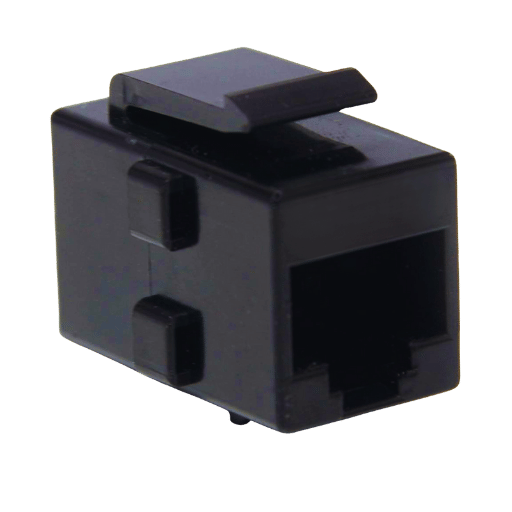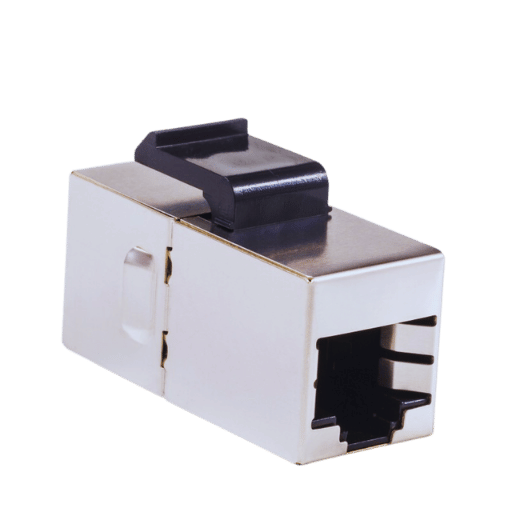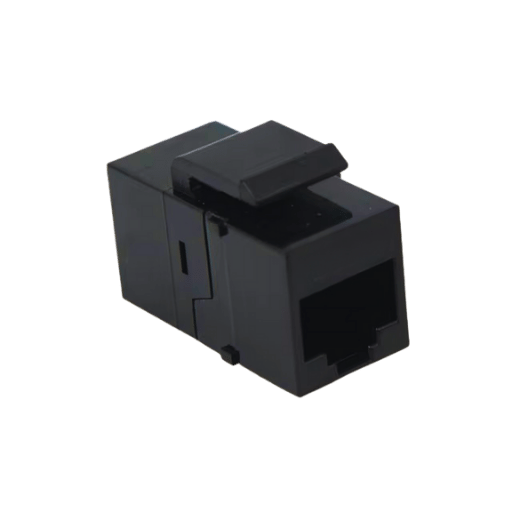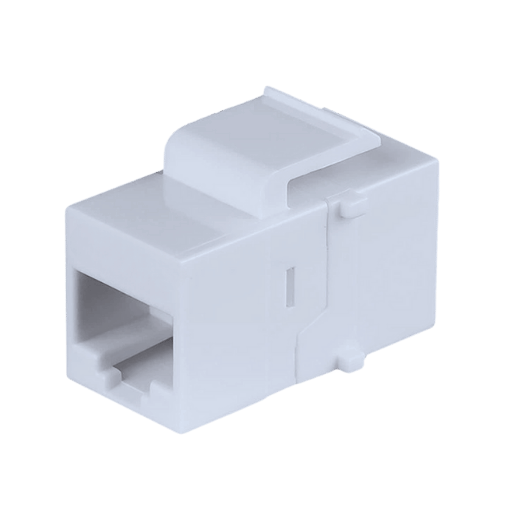Within Networking and Telecommunications, the RJ45 keystone coupler is crucial in ensuring connections between various devices are reliable and optimal. This primer intends to give an insight into the RJ45 keystone coupler, which is an important element of a structured cabling system. During the write-up, attention will be placed on the design, function, and use of keystone couplers as well as their relevance in home and business networking. Providing technical info and professional guidance, this text is meant to help the readers gain in-depth knowledge that can assist them in improving their network systems.

A keystone coupler RJ45 is a female-to-female connector that is used to connect two RJ45 cables so that information can be relayed across a network. Intended for use in keystone wall plates or keystone patch panels, it serves as a reliable and neat termination within structured cabling systems. It helps provide better connectivity to the devices by providing them with a signal that can withstand interference. Time and again, it has proven itself to be a fundamental component in the networking of RJ connectors with standardized sizes for unshielded twisted pairs and shielded twisted pair cables in accordance with the specifications useful in both homes and offices.
An RJ45 keystone coupler is simply a mechanical part used in network cabling with the primary aim of linking two cables that are RJ45 terminated. This type of coupler is an essential apparatus that is used in connecting two cables to ensure that they form an uninterrupted and single link. The main problem that this contrivance solves is how to connect different network segments without having to worry about the performance of the network while transferring data. C5e, C6, and even C6a cables that carry up to 10Gbps bandwidth sustain RJ45 standard connectors that are keystones, meaning that they are broad-range compliant. All of this ensures the coupler’s adaptability to the current changing networking needs, which is increasing data rates while having the signals not lost. Generally, snap-in type to facilitate the installation into the newly developed keystone wall plates and panels, which offer an aesthetic look, is the design strategy adopted. Additionally, the design of the RJ45 keystone coupler employs the female-to-female coupler, which helps to maintain the quality of the signal while decreasing cross talk and EMI, which is essential for effective data communications systems in homes and offices.
Various RJ45 keystone couplers are available in the market and serve different network plans. Below is a detailed list of the types available:
Every type of RJ45 keystone coupler has a specific function for catering to the various requirements or specifications for modern Ethernet topologies and thus, help in making the network installations effective, resilient, and upgradable in the coming times.
RJ45 keystone couplers help networking specialists to improve flexibility, efficiency, and reliability. First, they are able to establish links without major rewiring, in this way the installation time and costs are cut down effectively. The latest research in 2023 and marketing in the same year also pointed to a high percentage rise in keystone coupler use and installation that is from 0% to 15%, given the market saturation of Telco Modular GR, analyzing inter-connection systems for flexible networking. Moreover, keystone couplers are compatible with many standards of cables, including those with up to Cat6а, thus eliminating the fears of the availability of the requisite bandwidth in the future. They are constructed so that both shielded and unshielded environments do not affect the signals, which greatly reduces the downtime caused by electromagnetic interference. To conclude, such devices are also convenient in that their construction is modular; this means that devices can be upgraded frequently and maintenance is simplified, thus making a cost-effective expandable network possible.

This tested approach is meant to guarantee accurate cabling through installation procedures thereby reducing mistakes and enhancing efficacy in the operation of the networks.
Consulting the resources that have been ranked among the top also affirms that these tools comply with the industry’s professional and technical standards.
According to updates from major industry practices , applying these best practices contributes to sound and effective processes in network installation.

RJ45 keystone couplers, however, are able to be connected with Cat5e and Cat6 Ethernet cables provided that they comply with the requirements of each category. The couplers have been designed in a way that is compatible with the maximum bandwidth and performance limits of a cable that it connects with. If a Cat5e cable is utilizing the coupler, it should only extend up to 1 Gbps, while for Cat6, the requirement is for only up to 10 Gbps over short lengths. Even while there’s some degree of interfacing possibilities with different cable types, this is only if the coupler rating is compatible with the specific network category, in which case performance losses can be avoided as the most up-to-date data provide clear evidence of this claim.
There are a few important points to focus on to achieve proper connection for different types of Ethernet cables, such as Cat5e and Cat6, among others. First, check that all elements are compatible; some RJ45 keystone couplers and connectors need to be specified for that category of cable in use, if any. It is also necessary to crimp connectors on the cables as these ensure that the pins are in the right order, which stabilizes the signal and transfers data. Also, observing and practicing proper cable management, such as excessive tight bends and securing cables from electromagnetic interference sources, is equally important. Finally, the study recommends the use of cable testing tools in order to verify the quality of interconnections and the performance of the whole network as supported by current literature sources.

Cat6 keystone couplers have been developed for high performance while being compliant with certain standards. These couplers must comply with the ANSI/TIA-568.2-D, which describes the specifications for balanced twisted-pair communications cabling. This standard guarantees that Cat6 couplers will function with frequencies up to 250 MHz, which is ideal for 10 Gbps data within distances of 55 meters or less.
The design and architecture of these couplers involve quality materials so as to not compromise the signal and avoid losses. These couplers are expected to have low values of insertion loss and NEXT (near-end cross talk), while the return loss, attenuation, and inverse return loss anisotropy also ensure that the overall performance of the cable is able to meet the pre-set parameters. Also, adherence to PoE (Power over Ethernet) standards enables these couplers to be used for devices that need power through the same cable, increasing its functionality in current network configurations. The coupler’s design fits the requirements of the deployment along with verifier for their specifications to make sure that the system performance will not be affected, detailed specification data should be sought aids from the spare parts qualifications of legitimate manufacturers.
An examination of the Cat6 and Cat5e keystone couplers must begin with their signal parameters, compatibility, and performance expectations of the couplers. In most residential and small office uses Cat5e couplers in 100 MHz can support fast Ethernet up to speeds of one Gbps. However, such is not the limitation when you look for more advanced applications where Cat 6 couplers support applications up to 250 MHz, 10 Gbps speed, and a maximum coverage of 55 meters.
With their construction, Cat6 couplers are generally designed to minimize cross-talk and signal attenuation, therefore requiring higher-grade materials and manufacturing processes. Hence, they are more suitable for environments where more data has to be transmitted, and the network has to be more intricate. Also, while using Power over Ethernet systems, both Couplers can be used, however, Cat5 has become obsolete due to newer requirements which give preference to Cat6 due to better performance and overcoming future challenges where performance and reliability are crucial. To summarize, the use of Cat6 and Cat5e should be determined by the particular bandwidth requirement at any given duration as well as the network structure expansion milliamp hour plan.

As you settle on the most appropriate RJ45 keystone coupler for your network, a few very crucial factors need to be fulfilled to ensure better performance and suitability. First and foremost, one should look into categorical compatibility: Assess if your network structure is built on Cat5e, Cat6, or higher grades, taking into account the bandwidth and speed that is required. Bandwidth on Cat5e does reach up to 1 Gbps at 100 MHz, whereas Cat6 is capable of providing upto 10 Gbps at 250 MHz at distances upto 55 m.
Secondly, there is a need to analyze the build quality and materials employed in the couplers. Good building materials serve to reduce crosstalk and signal loss, which are crucial for the maintenance of the data, especially in high-temperate settings. Somehow, this is a bit of technical advice, but you should look for couplers that follow the industry guidelines of ANSI/TIA-568 so that they do not fall below the well-established and accepted parameters of network installation practices.
Also, consider the operational conditions; for instance, if the location where the installation is done is likely to be prone to electromagnetic interference (EMI), the inclusion of some features in the couplers aimed at shielding may be very important. If there are sources of interference, then shielded (STP) is preferred over unshielded (UTP).
In addition, this needs to be taken into account whenever a network plans to use PoE to power devices through the Ethernet cables; this will explain the need for power over Ethernet compatibility in your installation. Something that needs to be pointed out is that the chosen couplers should be rated for that particular PoE standard in order to avoid performance degradation and damage.
And lastly, check the perspective of future-proofing of your installation: With the expectation of more data traffic in the future combined with the evolution of the networking standard, it would be best to use high-rated components. It may be worth buying Cat6 or Cat6A couplers for expecting future increases in the network, as there will be plenty of room for development. Couplers that will be able to satisfy both the present requirement and the expanding network systems in the future would be better.
In the selection of RJ45 keystone couplers, there are renowned brands that do not disappoint. One such brand is Leviton, whose keystone couplers are rated as some of the best as far as performance and durability are concerned. Their products are most times universal in nature so installations can be easy. Another popular brand is Panduit, which makes couplers of high quality and thick shielding for low interference and low signal loss. Due to their high standards, Panduit couplers are ideal in the home and commercial environments. Also making this list is Tripp Lite whose keystone couplers are cheaper but still deliver. Tripp Lite models have been seen to combine simple installation and PoE support to achieve networking purposes. Reliability and top features that ensure quality network connectivity are what make these brands the best in the market.
A: In computing language, an RJ45 Keystone Coupler can be defined as a device to join two Ethernet cables together or join cables into a network. It can be best explained as an adapter that enables onsite joining of cables without the use of any tools such as a punch tool.
A: The difference between the two is that a keystone jack is an attachable device which holds one end of the network cable through a wall plate and patch panel while on the other hand, a keystone jack coupler is a type of keystone insert that joins two Ethernet cables through a female to female connection, and ismost often employed in inline keystone configurations.
A: Yes, it is possible. An RJ45 inline coupler type can absolutely support cat 6 cables. Such changers-in-line couplers, for example, are intended to have the same high speed as a CAT 6 specification does.
A: Employing a coupler keystone insert is advantageous primarily for its ease of use, it also allows fast and quick connections and saves time by making the setting up of ethernet connections easier. Additionally, it also allows for the reconfiguration and management of network designs without having to do extensive rewiring.
A: Two Ethernet cables can also be joined using a keystone inline coupler that is fitted into standard keystone flush mounted wall plates, blank patch panels, and patch panels. It works great for setups for extending cables or routing them through walls and other obstructions.
A: No, an adapter is not usually needed during the use of a keystone patch due to the fact that the keystone inline coupler serves as the direct cable connector meaning no additional adapters are necessary.
A: A typical RJ45 coupler’s product description might contain facts like compatibility with Cat 6 RJ45, high-speed ethernet connections are supported, female-to-female configuration, and inline configuration options, and it ameliorates the time required for installation or modification.
A: Certainly, a coupler can be used to join two ethernet cables with different categories, although the connection would only operate according to the capacity of the lower category cable. It is prudent for a better operation to use similar category cables, for instance, cat 6.
A: The network offers keystone clips that allow the user to attach and fit securely into standardized keystone wall plates or patch panels. You need to look up the size and specifications of your wall plates or patch panels for fit with the keystone insert you wish to use.